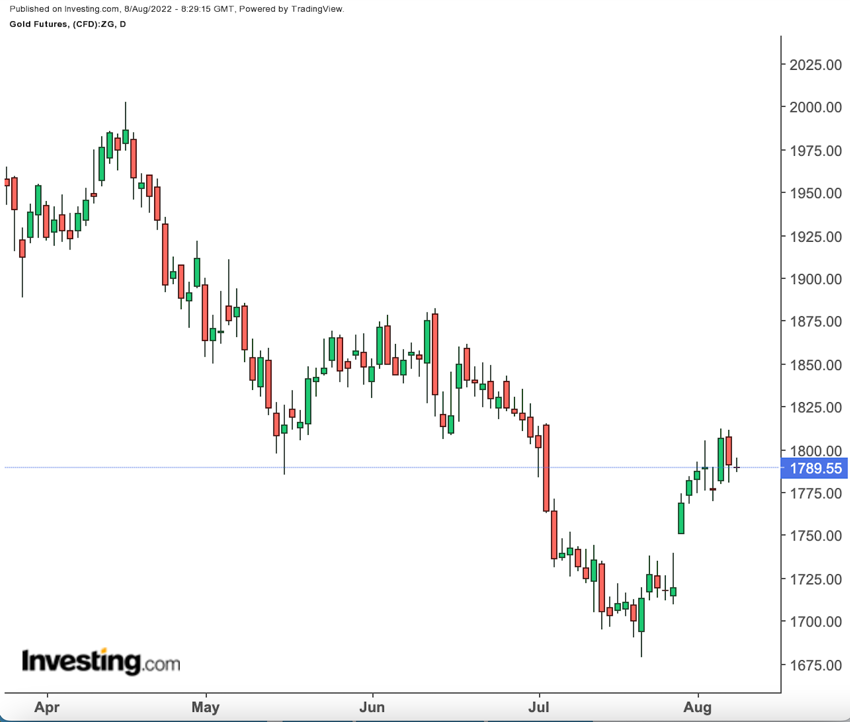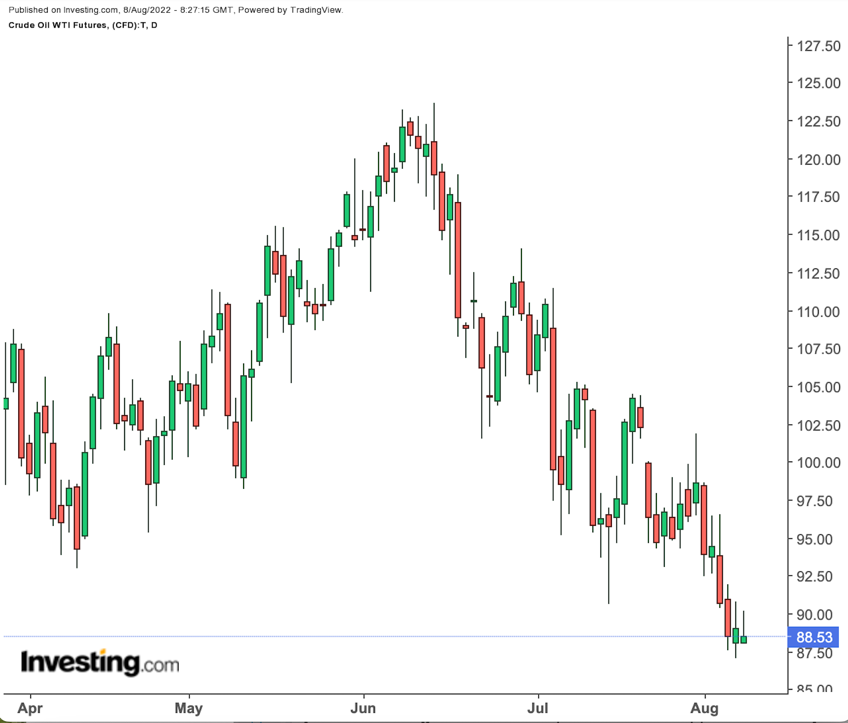- July CPI reading on Wednesday eagerly awaited across markets
- Headline inflation expected to cool, though it could surprise to the upside
- Oil, gold prices remain in a tight range ahead of the CPI numbers
What’s arguably the single most watched U.S. data is due for release this week and key commodities are trapped in tight trading ranges, with oil likely to be lower-bound while gold attempts to advance for a fourth straight week, in anticipation of what the Consumer Price Index (CPI) could show.

Economists tracked by Investing.com are projecting a growth of 8.7% in the CPI for the year to July, versus the rise of 9.1% during the 12 months to June. If true, it will be a sign that the Federal Reserve’s efforts in fighting inflation are starting to work.
Yet, a reduction of less than half a percent in year-on-year (yoy) inflation barely makes a difference to what the Fed is fighting. The central bank, as we all know, wants to bring inflation back to its long-cherished target 2% a year; or 4.5 times less than what the CPI was for July.
Pump prices of U.S. gasoline—one of the biggest components of CPI—has fallen from June record highs of $5 a gallon to under $4 now. That could certainly take some heat off the headline CPI number when the July update is released on Wednesday. Despite that, core CPI, stripped off volatile gasoline and food prices, is expected to increase by 0.5% month-over-month and 6.1% yoy.
What could be worse is that the headline CPI number turns out to be higher than June’s 9.1%. There is little likelihood it could be. But if it does, then where does that leave the Fed’s policy-making Federal Open Market Committee (FOMC)?
That’s the question that’s bugging traders of oil, gold and other dollar-denominated commodities.
Says Stephen Innes, managing director of the commodity-focused SPI Asset Management:
“Lately, the data the FOMC uses as critical inputs for its decision-making process has shown signs of an overheated labor market and intense wage pressures. Hence this week's inflation report seems very unlikely to offer 'compelling evidence' of a slowdown needed for the Fed to pull away from its aggressive inflation-fighting mode.”
Signs that inflation is still not peaking could dent expectations that the central bank will be able to stop hiking rates early next year, sending not just commodities but also stocks lower.
Adds Michael Antonelli, managing director and market strategist at Baird, in comments carried by Reuters:
"We’re at the point where consumer price data has reached a Super Bowl level of importance. It gives us some indication of what we and the Fed are facing."
The Fed has already hiked interest rates four times since March, bringing key lending rates from nearly zero to as high as 2.5%. It has another three revisions left before the year is over, with the first of that due on Sept. 21.
But Friday’s release of the July non-farm payrolls report changed all that as it confirmed an addition of 528,000 jobs versus economists’ expectations for an increase of just 250,000.
Until the release of the jobs data, the consensus among money market traders was for a 50 basis point hike next month. As of Friday though, there was a 62% chance that the September rate hike will be 75 basis points—the same as in June and July, which incidentally was the highest in 28 years when it was introduced two months back.
The real problem with the strong job numbers is the attendant pressure it brings on wages. U.S. hourly wages has risen month after month since April 2021, expanding by a cumulative 6.7% over the past 16 months, or an average of 0.4% a month.
Aside from the CPI, the producer price index (PPI) figures for July will be released on Thursday, along with the weekly report on initial jobless claims, while the University of Michigan consumer sentiment index will be published on Friday.
In Monday’s Asian trading of oil, Brent, the London-traded global benchmark for crude, was up 79 cents, or 0.8%, at $95.71 per barrel by 3:00 PM in Singapore (3:00 AM in New York). It lost about 14% in the last week of July for its worst weekly loss since the COVID-19 outbreak of April 2020 that virtually destroyed energy demand.
U.S. West Texas Intermediate (WTI) oil, which serves as the benchmark for U.S. crude, was up 74 cents, or 0.8%, to $89.75. WTI struck a six-month low of $87.01 per barrel on Friday. It lost about 10% in the last week of July.

Sunil Kumar Dixit, chief technical strategist at SKCharting.com, said a trade above $96.60 could change WTI’s short term momentum and set it up for a rally towards $99 and $101.
Otherwise, WTI could continue traveling south, toward the support cluster of $88-$85-$82, he said.
In the case of gold on New York’s COMEX, the benchmark December futures contract was up $3.55, or 0.2%, to $1,794.75 per ounce in Monday’s Asian trading. December gold tumbled to $1,780.20 an ounce on Friday but finished in the positive for a third week in a row.
SKCharting’s Dixit said for gold to continue its positive trajectory for a fourth running week, prices need to hold above $1,762 and the swing low of $1,754.
Disclaimer: Barani Krishnan uses a range of views outside his own to bring diversity to his analysis of anxy market. For neutrality, he sometimes presents contrarian views and market variables. He does not hold positions in the commodities and securities he writes about.
